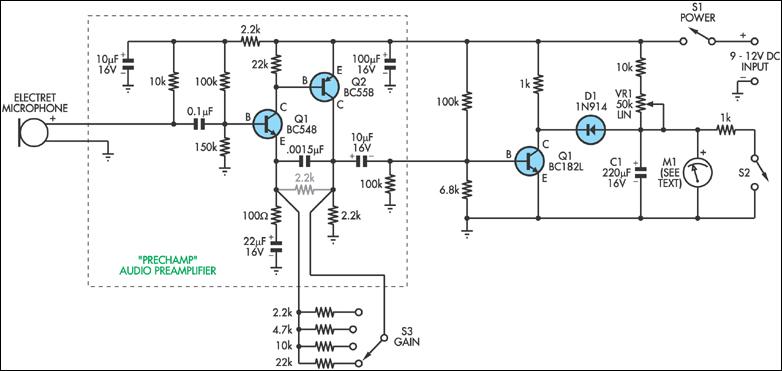Home » Circuits
Sound Source Locator Uses PreChamp
This circuit could be regarded as a simple alternative to the Sooper Snooper device featured elsewhere in this issue. It is based on the PreChamp preamplifier featured in the July 1994 issue of SILICON CHIP. It can be used to pinpoint or locate sounds coming from inconspicuous sources such as a noisy bearing in a VCR containing many bearings. Other examples are an audible gas leak or a puncture in a slowly deflating tyre, provided the background noise level is considerably less than the source noise.The device uses an electret microphone. This is attached to the end of round Texta casing of the same diameter, then covered with spaghetti sleeving and overlapping the electret by 5mm to make it more directional. The electret was then wired to the two-transistor Pre-Champ preamplifier (available from Dick Smith Electronics, Jaycar & Altronics as a kit). The 2.2kΩ feedback resistor in the preamplifier is replaced with switch S1 and four resistors – 2.2kΩ, 4.7kΩ, 10kΩ and 22kΩ – to give gains of 23, 48, 101 and 221, respectively.
Circuit diagram:
After passing through the modified PreChamp, the signal goes to the base of Q1 which is biased on the verge of turning on by the 100kΩ and 6.8kΩ resistors. When the electret microphone picks up a sound, the amplified signal is fed to the base of Q1 turning it on and drawing current via diode D1 to reduce the stored charge in C1, the 220μF electrolytic capacitor. This results in a dip in the reading of analog meter M1.
Meanwhile C1 is constantly being charged via the 10kΩ resistor and the 50kΩ trimpot VR1. VR1 is set to provide full scale deflection on meter M1 when no signal is present. If a 50uA meter movement is used it will required a suitable shunt resistor to suit the circuit. Summing up, as the unit is used to home in on a sound source, louder sounds cause the meter reading to drop. Frequencies below 20Hz will cause the meter pointer to flutter. Switch S2 and the associated 1kΩ resistor are provided to quickly discharge C1 to enable repeated measurements.
Author: P. Hetrelezis - Copyright: Silicon Chip

